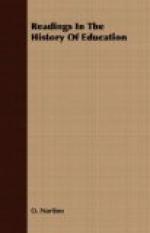In the Faculty of Arts:
1. The “three philosophies”—Natural, Moral, and Rational—of Aristotle, together with his Logic, Rhetoric, and Politics. Of these, Logic and Rhetoric are included below.
2. The Seven Liberal Arts, comprising
{Grammar.
(a)
{Rhetoric.
{Logic.
{Arithmetic.
(b)
{Geometry.
{Music.
{Astronomy.
In the Faculty of Law:
1. The Corpus Juris Civilis, or body of Roman Civil Law, compiled at Constantinople 529-533 A.D., under direction of the Roman Emperor Justinian.
2. The Canon Law, or law governing the Church, of which the first part was compiled by the monk Gratian about the year 1142. His compilation of the Canon Law is usually referred to as the Decretum Gratiani.
In the Faculty of Theology:
1. The “Sentences” of
Peter Lombard.
2. The Bible.
In the Faculty of Medicine:
1. The works of Hippocrates.
2. The works of Galen.
3. Medical treatises of various Arabic
and Jewish writers of the
seventh century A.D.
and later.
These studies will be described more fully in connection with the selections on pages 37-83.
Not all of the works mentioned under these divisions were included in the regular programme of any university; the actual studies required for the various degrees consisted rather in selections from these works. The selections chosen varied somewhat in different universities; moreover, the course in any given university changed from time to time. Consequently the degrees of A.B. and A.M., as well as degrees in Law, Medicine, and Theology, probably never represented exactly the same set of studies in any considerable number of universities, nor did they even represent exactly the same work for many years in any single university. This corresponds exactly with the situation in modern universities, although at present the variations in studies for the same degree are greater and the changes in any given university are usually more rapid than they were in the universities of the Middle Ages.
It is necessary to remember that all the text-books were in Latin. Those written originally in other tongues were translated into Latin. All university exercises were conducted in that language, and frequently the regulations required students to use Latin in conversation outside the lecture halls. Latin was, in short, the universal academic tongue. Obviously, the use of the same language everywhere facilitated the migration of students and teachers from one university to another.
7. Although the first universities were not established as organized institutions until the latter part of the twelfth century, the intellectual movement which gave rise to them was well under way a century earlier. It showed itself first in the rise of great teachers, some of whom were also notable scholars. There has never been a clearer demonstration of the central importance in education of the distinguished teacher:




